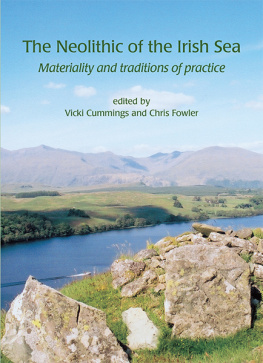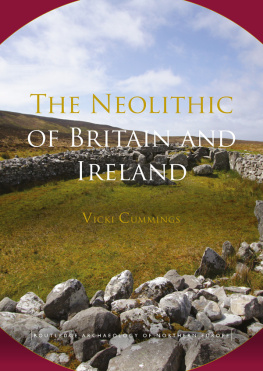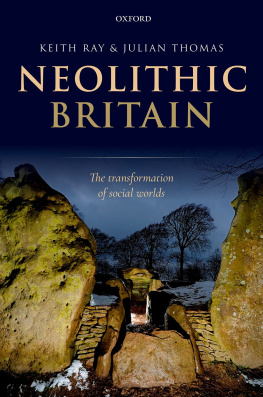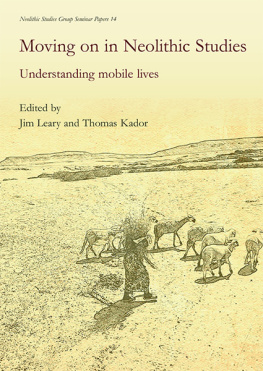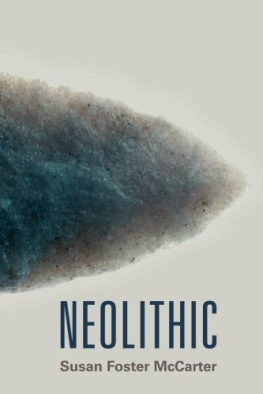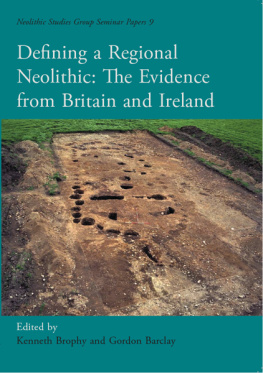Cummings Vicki - The Neolithic of the Irish Sea
Here you can read online Cummings Vicki - The Neolithic of the Irish Sea full text of the book (entire story) in english for free. Download pdf and epub, get meaning, cover and reviews about this ebook. year: 2015, publisher: Casemate Publishers & Book Distributors, LLC, genre: Politics. Description of the work, (preface) as well as reviews are available. Best literature library LitArk.com created for fans of good reading and offers a wide selection of genres:
Romance novel
Science fiction
Adventure
Detective
Science
History
Home and family
Prose
Art
Politics
Computer
Non-fiction
Religion
Business
Children
Humor
Choose a favorite category and find really read worthwhile books. Enjoy immersion in the world of imagination, feel the emotions of the characters or learn something new for yourself, make an fascinating discovery.
- Book:The Neolithic of the Irish Sea
- Author:
- Publisher:Casemate Publishers & Book Distributors, LLC
- Genre:
- Year:2015
- Rating:3 / 5
- Favourites:Add to favourites
- Your mark:
- 60
- 1
- 2
- 3
- 4
- 5
The Neolithic of the Irish Sea: summary, description and annotation
We offer to read an annotation, description, summary or preface (depends on what the author of the book "The Neolithic of the Irish Sea" wrote himself). If you haven't found the necessary information about the book — write in the comments, we will try to find it.
The Neolithic of the Irish Sea — read online for free the complete book (whole text) full work
Below is the text of the book, divided by pages. System saving the place of the last page read, allows you to conveniently read the book "The Neolithic of the Irish Sea" online for free, without having to search again every time where you left off. Put a bookmark, and you can go to the page where you finished reading at any time.
Font size:
Interval:
Bookmark:
Published in the United Kingdom in 2004. Reprinted in 2015 by
OXBOW BOOKS
10 Hythe Bridge Street, Oxford OX1 2EW
and in the United States by
OXBOW BOOKS
908 Darby Road, Havertown, PA 19083
Oxbow Books and the individual authors 2004
Paperback Edition: ISBN 978-1-84217-109-7
Digital Edition: ISBN 978-1-78570-036-1
Kindle Edition: ISBN 978-1-78570-037-8
PDF Edition: ISBN 978-1-78570-038-5
A CIP record for this book is available from the British Library
All rights reserved. No part of this book may be reproduced or transmitted in any form or by any means, electronic or
mechanical including photocopying, recording or by any information storage and retrieval system, without permission
from the publisher in writing.
For a complete list of Oxbow titles, please contact:
UNITED KINGDOM
Oxbow Books
Telephone (01865) 241249, Fax (01865) 794449
Email:
www.oxbowbooks.com
UNITED STATES OF AMERICA
Oxbow Books
Telephone (800) 791-9354, Fax (610) 853-9146
Email:
www.casemateacademic.com/oxbow
Oxbow Books is part of the Casemate Group
Front cover: Port Sonachan chambered cairn, western Scotland.
Photo: Vicki Cummings
For Alasdair and Julian
Contents
(Vicki Cummings and Chris Fowler)
(Alison Sheridan)
(Rick J. Schulting)
(Vicki Cummings)
(Kenneth Brophy)
(Timothy Darvill)
(Aaron Watson)
(Cole Henley)
(Colin Richards)
(Alasdair Whittle)
(Chris Fowler)
(Edward Evans and Thomas A. Dowson)
(Vicki Cummings and Chris Fowler)
(Helen Evans)
(Peter Davey)
(Gabriel Cooney)
(Keith Ray)
(Julian Thomas)
(David Mullin)
(Rick Peterson)
(Andrew Jones)
(Jenny Woodcock)
(Marcus Brittain)
(Trevor Kirk)
Preface
Julian Thomas
The concept of an Irish Sea zone in prehistory is one that has a long history (Waddell 1991). It is curious, then, that it should now be re-emerging as part of a new phase in the development of Neolithic and early Bronze Age studies. Gordon Barclay (2001) has cogently argued that our study of these periods has been dominated by an over-emphasis on certain luminous centres, principally Wessex and Orkney. These areas have plentiful upstanding monuments, and as a consequence have attracted the attention of antiquarians and archaeologists for many generations. Numerous excavations have been undertaken, and museum basements have been filled with project archives and stray finds. None of this means, however, that these areas were necessarily of pre-eminent importance in the Neolithic. Other traditions of monumentality from those that characterise the core areas of study, which leave a less durable trace, and other social practices entirely, may have been of equal importance to people in the past.
This history of research has had other consequences. In the early 1980s, a series of new approaches to the Neolithic and early Bronze Age began to emerge, influenced by recent developments in archaeological thought (Bradley and Gardiner 1984; Braithwaite 1984). These accounts of the period addressed themes of ideology, social power, material symbolism, stylistic variation, depositional activity, identity and ritual action, and were critical of culture-historic narratives based around peoples and invasions. In order to create more subtle analyses, they often required extensive sets of evidence: suites of burials, well-recorded and contextually located assemblages of ceramics, lithics and faunal remains. The tendency was to seek these in the geographical areas that had seen the most intensive field research, thereby reinforcing the hegemony of Wessex and Orkney. This was particularly the case because much of this work was undertaken by research students, who lacked the resources to carry out extensive field projects of their own. The areas surrounding the Irish sea, save for Ireland itself, have had a reputation for producing rather scarce assemblages of material culture, and were somewhat neglected by the social archaeologies the 1980s.
More recently, a series of changes in the character of research have contributed to a shift of focus. Firstly, there has been a growing interest in the experiential aspects of landscape, architecture and monuments (Cooney 2000; Tilley 1994). While excellent work had been continuing in western Scotland, Wales and the Isle of Man throughout (e.g. Gibson 1994; Smith and Lynch 1987), these preoccupations drew a new generation of researchers to work in these areas (Cummings 2002; Fowler 2001). Secondly, there was a greater willingness to make the most of the supposedly meagre artefactual resources of the Irish Sea area (Burrow 1997; Peterson 2003; Squair 1998). Thirdly, some of the very scholars who were prominent in the Wessex and Orkney-centred archaeology of the early 1980s, subsequently expanded their fieldwork interests into other zones (e.g. Bradley 2000; Bradley and Edmonds 1993). Finally, there was a growing appreciation of the extent of regional variation in the Neolithic and early Bronze Age (Sharples 1992), which lent credence to arguments like Barclays, criticising a myopic focus on one or two regions judged to be paradigmatic of the period.
The papers in this volume address a series of regions, some of which have been judged to be peripheral in previous work. But importantly, they do so within the broader framework of the Irish Sea zone. There is, of course, a danger of reifying such an entity into a cultural hearth of some kind. But it is valuable to consider the interactions, similarities and contextual variations in the use of material things between communities surrounding a major body of water, thereby undercutting the illusory homogeneity of English prehistory, Welsh prehistory, Irish prehistory or Scottish prehistory.
References
Barclay, G. 2001. Metropolitan and parochial/core and periphery: a historiography of the Neolithic of Scotland. Proceedings of the Prehistoric Society 67, 118.
Bradley, R.J. 2000. The good stones: a new investigation of the Clava Cairns. Edinburgh: Society of Antiquaries of Scotland.
Bradley, R. and Edmonds, M. 1993. Interpreting the axe trade. Cambridge: Cambridge University Press.
Bradley, R.J. and Gardiner, J. (eds) 1984. Neolithic studies. Oxford: British Archaeological Reports British Series 133.
Braithwaite, M. 1984. Ritual and prestige in the prehistory of Wessex c.20001400 BC: a new dimension to the archaeological evidence. In D. Miller and C. Tilley (eds), Ideology, power and prehistory, 93110. Cambridge: Cambridge University Press.
Burrow, S. 1997. The Neolithic pottery of the Isle of Man: a study in production, decoration, and use. Unpublished Ph.D. thesis: University of Bournemouth.
Cooney. G. 2000. Landscapes of Neolithic Ireland. London: Routledge.
Cummings, V. 2002. Between mountains and sea: a reconsideration of the Neolithic monuments of south-west Scotland. Proceedings of the Prehistoric Society 68, 12546.
Fowler, C. 2001. Personhood and social relations in the British Neolithic, with a study from the Isle of Man. Journal of Material Culture 6, 13764.
Gibson, A. 1994. Excavations at Sarn-y-bryn-caled cursus complex, Welshpool, Powys. Proceedings of the Prehistoric Society 60, 143224.
Peterson, R. 2003. Neolithic pottery from Wales: traditions of construction and use. Oxford: British Archaeological Reports British Series 344.
Sharples, N. 1992. Aspects of regionalisation in the Scottish Neolithic. In: N. Sharples and A. Sheridan (eds), Vessels for the ancestors
Next pageFont size:
Interval:
Bookmark:
Similar books «The Neolithic of the Irish Sea»
Look at similar books to The Neolithic of the Irish Sea. We have selected literature similar in name and meaning in the hope of providing readers with more options to find new, interesting, not yet read works.
Discussion, reviews of the book The Neolithic of the Irish Sea and just readers' own opinions. Leave your comments, write what you think about the work, its meaning or the main characters. Specify what exactly you liked and what you didn't like, and why you think so.

